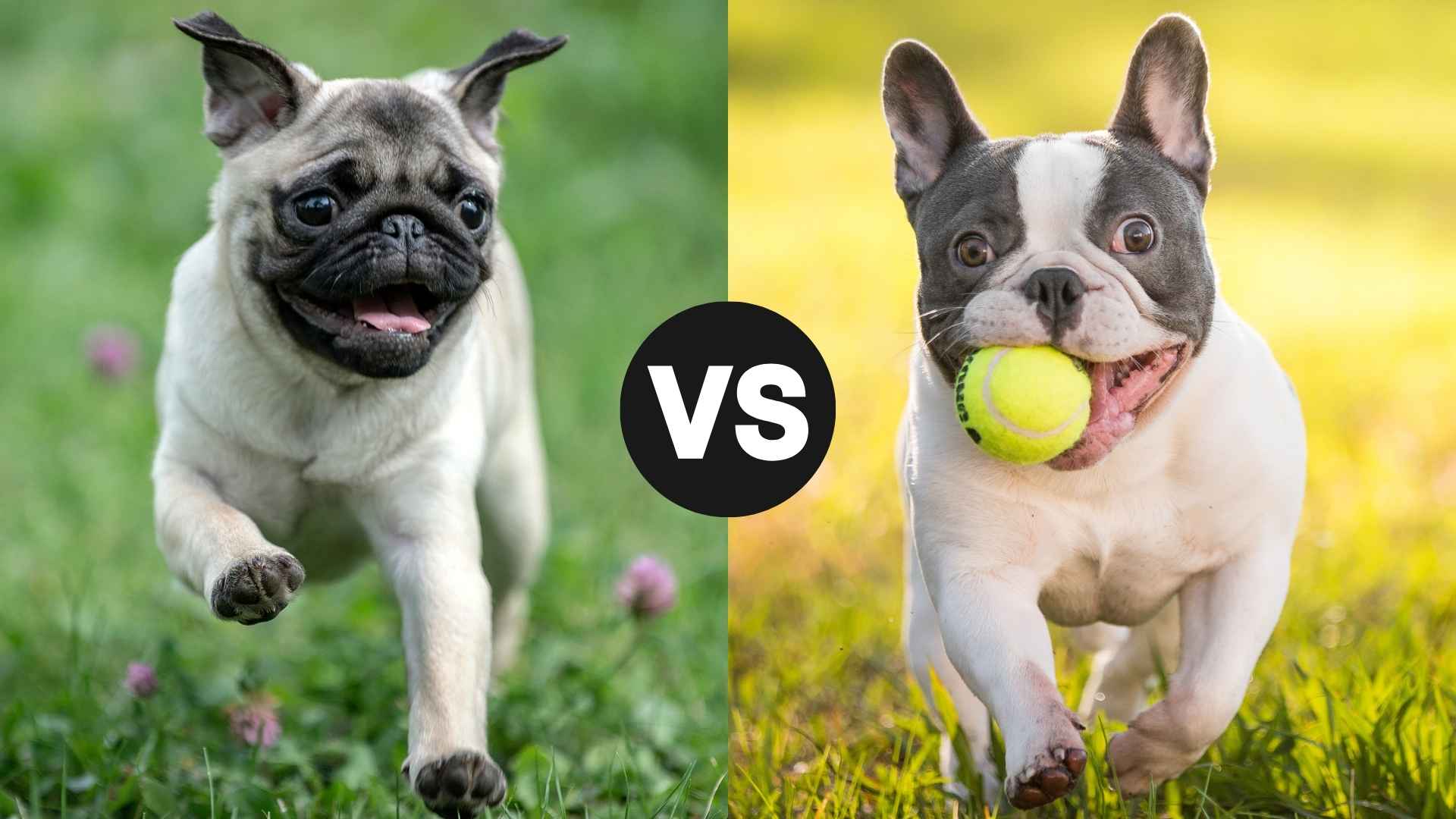Both the Pug and the French Bulldog are small, charming, and full of personality, making them two of the most lovable companion breeds. Choosing between these two affectionate and compact dog breeds can be challenging, as both share similar characteristics yet have distinct differences.
Their temperament, exercise needs, grooming requirements, and potential health concerns vary, which can influence your decision. Understanding these differences is crucial in determining which breed aligns best with your lifestyle. Some may prefer a more active and energetic companion, while others may seek a laid-back, low-maintenance pet.
This detailed comparison’ll explore the key aspects that set these breeds apart, including their history, physical traits, behavior, and care needs. By the end of this guide, you’ll understand which of these lovable companions would be the perfect fit for your home and heart.
Pug vs. French Bulldog
The Pug is a small, charming breed known for its wrinkled face, curled tail, and playful personality. Originating from China, these dogs were bred as companion pets for royalty, which explains their affectionate and people-oriented nature.
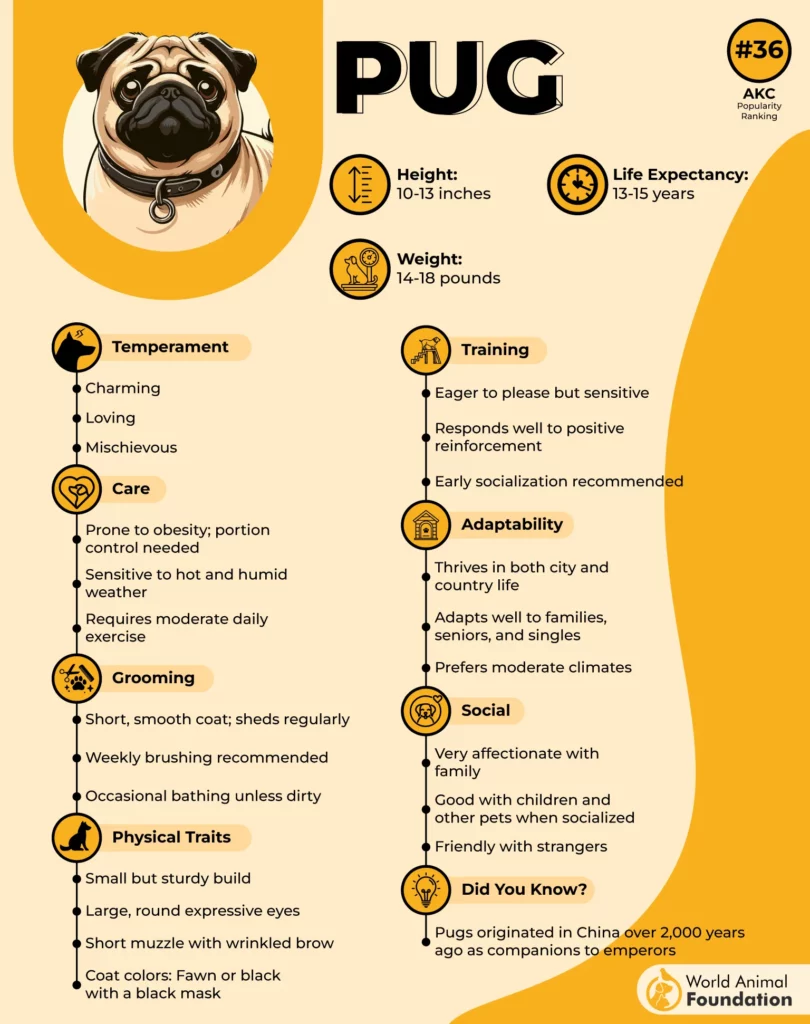
Pugs are known for their mischievous, fun-loving demeanor, often entertaining their owners with silly antics. They are social dogs that thrive on human interaction and can sometimes be quite stubborn. While they enjoy bursts of playtime, they don’t require excessive exercise, making them suitable for apartment living.
The French Bulldog, originally bred as a companion dog for lace workers in France, is a sturdy, muscular breed with bat-like ears and a distinctive, expressive face. Unlike the lively and mischievous Pug, French Bulldogs are typically more laid-back and adaptable, making them excellent companions for both individuals and families.

They have a calm and affectionate temperament but can also be quite stubborn regarding training. Frenchies require minimal exercise and are content with short walks and indoor play, making them ideal for urban living.
Pug vs. French Bulldog: History
AKC states that the Pug has a long and noble history dating back over 2,000 years to ancient China, where they were bred as royal lapdogs for Chinese emperors. These small dogs were highly valued for their affectionate nature and great companionship, often living in luxury within imperial palaces.

Their curly tail and round body made them easily recognizable, and their popularity eventually spread to Europe through Dutch traders in the 16th century. In Europe, they became one of the most popular breeds among the nobility, particularly in Holland and England, where they were associated with the House of Orange.
The French Bulldog originated in the 19th century when English lace workers migrated to France, bringing English Bulldogs and smaller bulldog-type dogs. These dogs were later bred with local terriers and Pugs, creating the French Bulldog personality known for its affectionate, playful, yet relaxed nature.
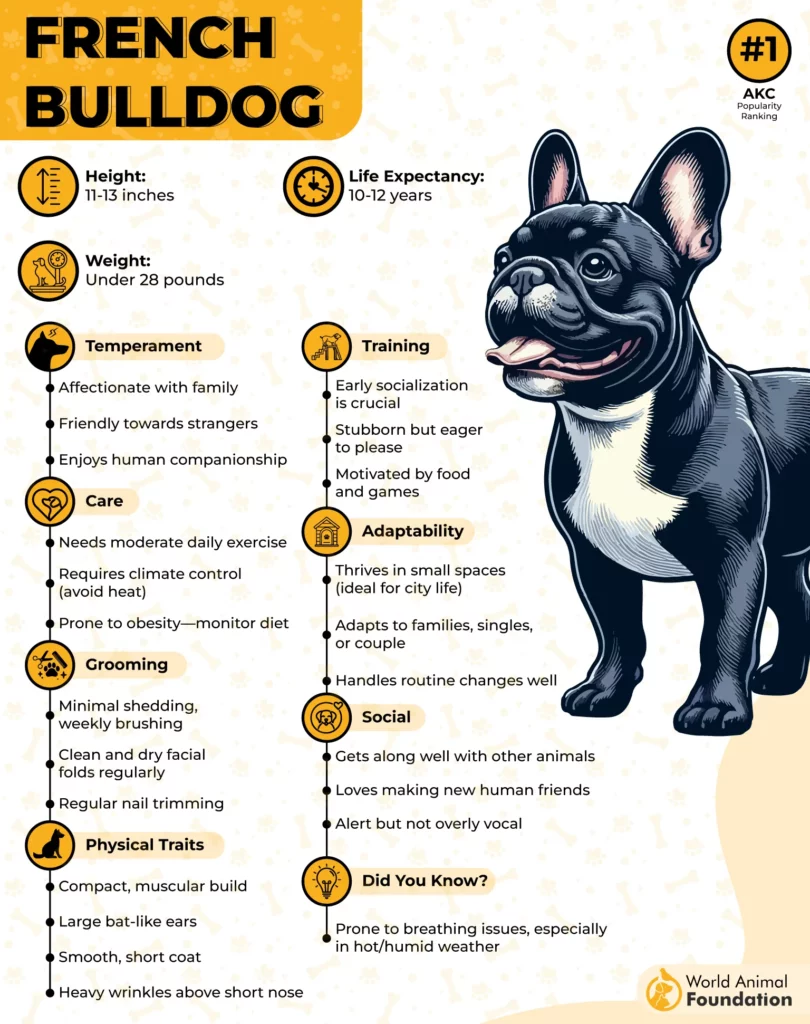
With their short legs, more round bodies, and unique characteristics like bat-like ears, Frenchies quickly became favorites among the Parisian elite and artists. They are now considered one of the most popular breeds for city dwellers due to their adaptable and low-maintenance lifestyle.
Pug vs. French Bulldog: Size and Weight
The Pug is a compact and sturdy small breed, typically weighing between 14 to 18 pounds and standing around 10 to 13 inches tall at the shoulder. Despite their small size, they have a slightly square-shaped body with a curled tail and a well-muscled frame.
Their distinctive round head, short muzzle, and deep facial wrinkles give them a unique appearance. Pugs are not overly delicate but should be handled with care due to their brachycephalic (flat-faced) structure, which can affect their breathing and overall endurance.
The French Bulldog is slightly larger and more muscular, weighing between 16 to 28 pounds and standing about 11 to 12 inches tall. They have a compact, well-proportioned build with a broad chest and a distinctive “bat ear” shape that sets them apart.

Their tails are short and either straight or slightly screwed. Frenchies have a sturdy bone structure, making them slightly heavier than their small stature might suggest. Despite their solid build, they are not highly active dogs and are best suited for moderate exercise routines.
Pug vs. French Bulldog: Coat
The Pug has a short, smooth, glossy coat that lies close to the body. Their fur is typically fine and soft, requiring minimal grooming. Pugs come in a few standard colors, with fawn and black being the most common.
Due to their short hair, they shed consistently throughout the year, especially during seasonal changes. Regular brushing, at least once or twice a week, helps manage shedding and keeps their coat healthy. Their deep facial wrinkles also require frequent cleaning to prevent dirt buildup and skin infections.
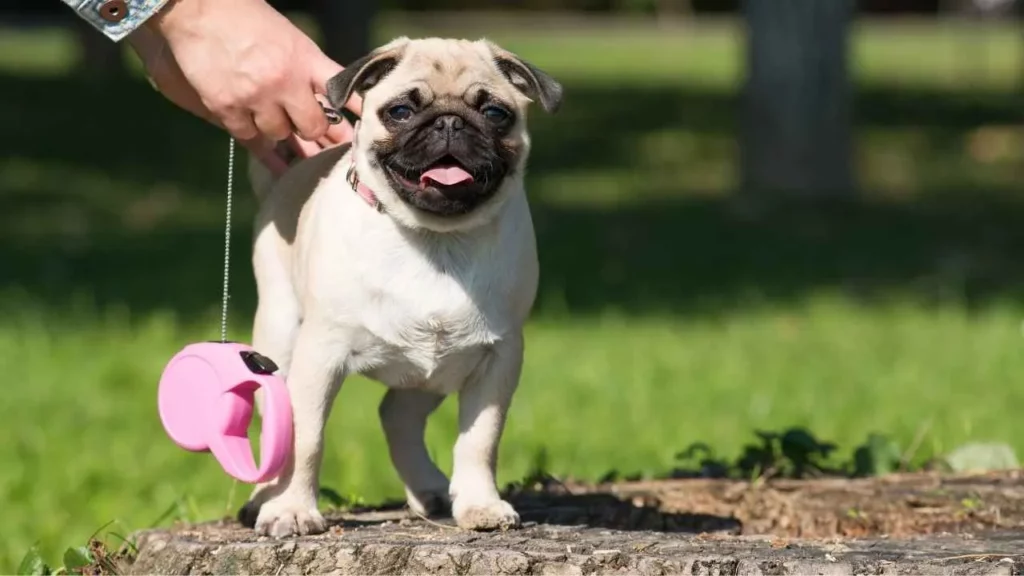
The French Bulldog also has a short and smooth coat, which is slightly denser than a Pug’s. Their fur is low-maintenance, with moderate shedding that can be controlled through regular brushing. Frenchies come in various colors, including fawn, brindle, cream, white, and various pied patterns.
They do not have deep wrinkles on their face, making their grooming needs slightly easier. However, they may still be prone to skin allergies, requiring owners to regularly monitor their coat and skin condition.
Pug vs. French Bulldog: Temperament
The Pug is known for its affectionate, playful, and mischievous temperament. They thrive on human interaction and are highly social, making them excellent companions for families, singles, and seniors.
Pugs have fun-loving and clownish personalities, often entertaining their owners with silly antics. They are generally friendly with children and other pets, but their stubborn streak can make training challenging. Despite their occasional stubbornness, they are eager to please and respond well to positive reinforcement.
The French Bulldog has a more laid-back and adaptable temperament, making them ideal for city living and quieter households. They are affectionate and loyal and enjoy being close to their owners, often forming strong bonds with their families.
While they have a playful side, Frenchies are generally a calmer dog breed than Pugs and do not require as much attention or stimulation. They can be a bit stubborn regarding training, but their intelligent and easygoing nature makes them relatively easy to manage with patience and consistency.
Pug vs. French Bulldog: Grooming and Maintenance
The Pug has a short, smooth coat that sheds consistently throughout the year, requiring regular brushing at least twice a week to control loose hair. Their deep facial wrinkles need special attention, as dirt and moisture can accumulate, leading to infections.
Cleaning their wrinkles with a damp cloth and drying them thoroughly is essential for their hygiene. Pugs are also prone to eye issues such as eye discharge due to their prominent eyes, so regular wiping is necessary. Bathing should be done once a month or as needed, using a gentle dog shampoo to maintain their skin health.
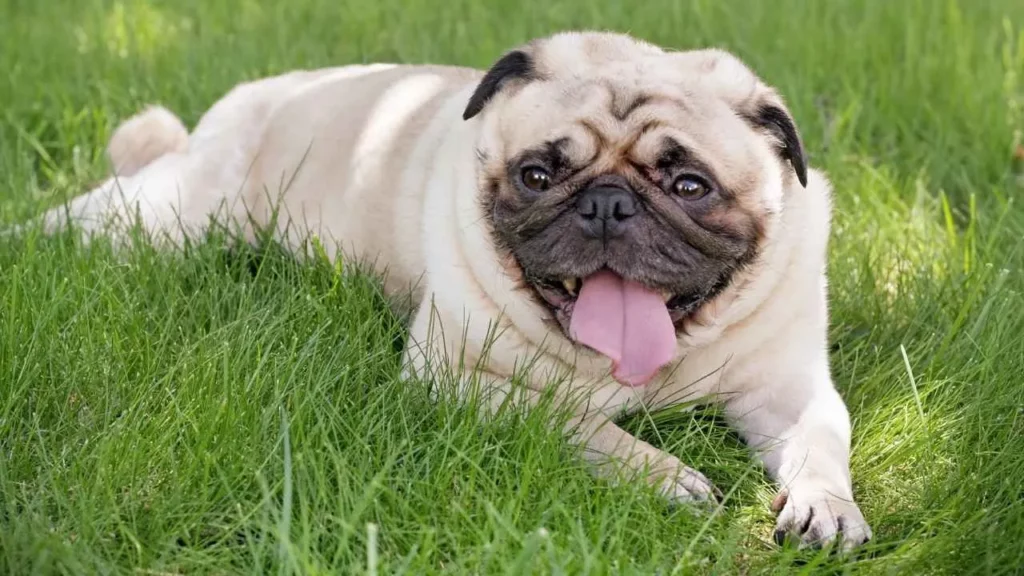
The French Bulldog also has a short coat, but it sheds slightly less than a Pug. Weekly brushing is sufficient to keep their fur clean and reduce shedding. Unlike Pugs, they have fewer facial wrinkles, making their grooming routine slightly easier.
However, they can still develop skin allergies, so monitoring their coat and using hypoallergenic products when needed is important. Their ears, due to their bat-like shape, require regular cleaning to prevent infections. Like Pugs, Frenchies should be bathed occasionally and kept dry to avoid skin issues.
Pug vs. French Bulldog: Health and Lifespan Comparison
Pugs tend to have a lifespan of 12 to 15 years, but like many flat-faced breeds, they are prone to various health issues. Their short snouts contribute to breathing issues, particularly in hot weather, leading to heat intolerance if they overexert themselves.
As per PetMD, other common health concerns include obesity, hip dysplasia, and eye problems such as cherry eye, corneal ulcers, and dry eye. Their deep facial wrinkles, if left unattended, can trap moisture and lead to skin infections.
Regular vet check-ups, a balanced food diet, and brushing their teeth daily can help maintain their overall health. Despite these concerns, pugs love human companionship and enjoy interactive games like hide and seek, making them great companions when properly cared for.
Both French Bulldogs and Pugs share some genetic health issues, but a French Bulldog puppy generally has a shorter lifespan of 10 to 12 years. Their stocky build and short snouts make them susceptible to breathing problems, and their floppy ears require frequent cleaning to prevent infections.

PDSA states, Frenchies are also prone to hip dysplasia, spinal disorders, and allergies, which can lead to more health problems over time. Additionally, due to their narrow hips, they often require C-sections during birth, making it crucial to choose an ethical breeder or a reputable breeder when getting a puppy.
Like Pugs, they need regular vet visits, proper food intake, weekly brushing, and potential pet insurance to manage their health problems. While they may experience separation anxiety and require extra care, French Bulldogs and Pugs can lead happy, fulfilling lives with responsible ownership.
Conclusion
In conclusion, both the Pug and French Bulldog make affectionate and charming companions, each with unique traits. Pugs, with their playful and energetic nature, thrive on companionship and enjoy an active lifestyle despite their compact size.
On the other hand, French Bulldogs are known for their laid-back attitude and adaptability, making them excellent apartment pets. While both breeds are prone to respiratory issues due to their brachycephalic (flat-faced) structure, proper care, diet, and exercise can help them lead healthy lives.
Ultimately, choosing between a Pug and a French Bulldog depends on your lifestyle and preferences, as both breeds bring endless love and personality to their owners.


